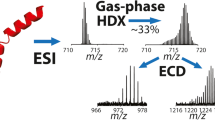Abstract
The methods of the α-proton chemical shift index (CSI) and the amide proton (NH) chemical shift temperature coefficient (Δδ/ΔT) were found experimentally by a number of studies on proton NMR chemical shifts of peptides and proteins in an aqueous solution, and have been widely accepted. They provide an insight into secondary structures and intra-molecular hydrogen bonds in peptides and proteins without complex calculation. Our question is whether the methods are applicable to helical peptides in methanol. Melittin, a peptide of 26 amino acid residues found in bee venom, has been known to consist of two helices (the residues 2–11 and 13–26) connected by a kink section (the residues 11–13). Employing the methods for melittin in methanol, we have shown that most of the CSI’s for the residues 3–10 and 14–26 are − 1, and the Δδ/ΔT’s for the residues 5–26 except 6 and 14 are more positive than − 6 ppb/℃. If the methods are applicable to melittin in methanol, these results indicate that helix structures are formed in the regions of the residues 3–10 and 14–26 and NH’s in the residues 5–26 except 6 and 14 are involved in intra-molecular hydrogen bonds. The helical structure evaluated from the methods, hence, agrees nearly with the known helix structure. We also apply the methods to D-Pro14 melittin (synthetic melittin) and alamethicin (a peptide of 20 amino acid residues) in methanol, and show that they virtually work well.








Similar content being viewed by others
Change history
04 November 2022
A Correction to this paper has been published: https://doi.org/10.1007/s10930-022-10085-2
References
Wishart DS, Sykes BD, Richards FM (1992) The chemical shift index: a fast and simple method for the assignment of protein secondary structure through NMR spectroscopy. Biochemistry 31:1647–1651
Cierpicki T, Otlewski J (2001) Amide proton temperature coefficients as hydrogen bond indicators in proteins. J Biomol NMR 21:249–261
Baxter NJ, Williamson MP (1997) Temperature dependence of 1H chemical shifts in proteins. J Biomol NMR 9:359–369
Andersen NH, Neidigh JW, Harris SM, Lee GM, Liu Z, Tong H (1997) Extracting information from the temperature gradients of polypeptide NH chemical shifts. 1. The importance of conformation averaging. J Am Chem Soc 119:8547–8561
Wishart DS, Sykes BD, Richards FM (1991) Relation between nuclear magnetic resonance chemical shift and protein secondary structure. J Mol Biol 222:311–333
Merutka G, Dyson HJ, Wright PE (1995) ‘Random coil’ 1H chemical shifts obtained as a function of temperature and trifluoroethanol concentration for the peptide series GGXGG. J Biomol NMR 5:14–24
Dyson HJ, Rance M, Houghten RA, Lerner RA, Wright PE (1988) Folding of immunogenic peptide fragments of proteins in water solution. I. Sequence requirements for the formation of a reverse turn. J Mol Biol 201:161–200
Rothemund S, Weißhoff H, Beyermann M, Krause E, Bienert M, Mügge C, Sykes BD, Sönnichsen FD (1996) Temperature coefficients of amide proton NMR resonance frequencies in trifluoroethanol: a monitor of intramolecular hydrogen bonds in helical peptides? J Biomol NMR 8:93–97
Krebs D, Maroun RG, Sourgen F, Troalen F, Davoust D, Fermandjian S (1998) Helical and coiled-coil-forming properties of peptides derived from and inhibiting human immunodeficiency virus type 1 integrase assessed by 1H-NMR. Use of NH temperature coefficients to probe coiled-coil structures. Eur J Biochem 253:236–244
Mineev KS, Nadezhdin KD (2017) Membrane mimetics for solution NMR studies of membrane proteins. Nanotechnol Rev 6(1):15–32
Miura Y (2021) Nuclear magnetic resonance studies on conformation and stability of mastoparan in methanol.J Pep Scie3338
Bazzo R, Tappin MJ, Pastore A, Harvey TS, Carver JA, Campbell ID (1988) The structure of melittin. A 1H-NMR study in methanol. Eur J Biochem 173:139–146
Dempsey CE (1988) pH dependence of hydrogen exchange from backbone peptide amides of melittin in methanol. Biochemistry 27:6893–6901
Iwadate M, Asakura T, Dubovskii PV, Yamada H, Akasaka K, Williamson MP (2001) Pressure-dependent changes in the structure of the melittin α-helix determined by NMR. J Biomol NMR 19:115–124
Hewish DR, Barnham KJ, Werkmeister JA, Kirkpatrick A, Bartone N, Liu ST, Norton RS, Curtain C, Rivett DE (2002) Structure and activity of D-Pro14 melittin. J Protein Chem 21:243–253
Miura Y (2020) NMR studies on the conformation, stability and dynamics of alamethicin in methanol. Eur Biophys J 49:113–124
Yee AA, Babiuk R, O’Neil JDJ (1995) The conformation of an alamethicin in methanol by multinuclear NMR spectroscopy and distance geometry/simulated annealing. Biopolymers 36:781–792
Rajan R, Balaram P (1996) A model for the interaction of trifluoroethanol with peptides and proteins. Int J Peptide Res 48:328–336
Wishart DS, Sykes BD (1994) The 13 C Chemical-Shift Index: A simple method for the identification of protein secondary structure using 13 C chemical-shift data. J Biomol NMR 4:171–180
Author information
Authors and Affiliations
Corresponding author
Additional information
Publisher’s Note
Springer Nature remains neutral with regard to jurisdictional claims in published maps and institutional affiliations.
The original version of this article was revised: due to some errors in Figures 4 & 5 and Table 4.
Rights and permissions
Springer Nature or its licensor holds exclusive rights to this article under a publishing agreement with the author(s) or other rightsholder(s); author self-archiving of the accepted manuscript version of this article is solely governed by the terms of such publishing agreement and applicable law.
About this article
Cite this article
Miura, Y. α-proton Chemical Shift Index and Amide Proton Chemical Shift Temperature Coefficient of Melittin in Methanol: Indicators for a Helix Structure and an Intra-Molecular Hydrogen Bond?. Protein J 41, 625–635 (2022). https://doi.org/10.1007/s10930-022-10075-4
Accepted:
Published:
Issue Date:
DOI: https://doi.org/10.1007/s10930-022-10075-4




